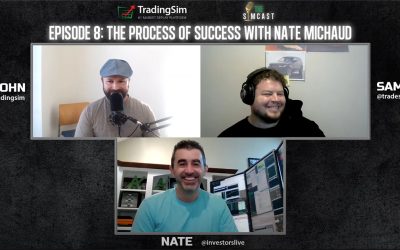How much higher would your trading profits be if your losses were cut in half?
How much higher would they be if you only lost half as frequently?
Most traders focus on chasing profits and forget that minimizing losses can have the same net impact on your bottom line. Protecting yourself from an additional $500 trading loss has the same impact as increasing your profits by $500.
Today, we are going to reframe the question, “how can I make more money from trading?” as “how can I lose less money while trading?”
This question is relevant to all traders, whether you are still working towards profitably or already generating consistent profits from trading.
We can all benefit from minimizing losses.
Here are some tips to get you started.
1. Stay Away From Trades Out of Your League
The best way to avoid trouble is to stay away from trouble.
Trading is risky by nature, but certain trades are riskier than others.
Traders mitigate risk by trading in their zones. They stay in their lanes and avoid the unknown.
If you don’t feel comfortable with a trade, avoid it. It’s better to regret not taking a trade than it is to regret actually taking it.
View this post on Instagram
2. Never Put Your Career in Jeopardy
Trading is a marathon. The most successful traders have been consistently profitable over a long period of time. They don’t risk their entire careers for a single trade. It’s not worth it.
Longevity is key and your #1 goal is to keep yourself in the game.
Your career isn’t going to be defined by a single trade – don’t let it get destroyed by one either.
View this post on Instagram
3. Don’t Trade Too Big Too Soon
Traders are ambitious to capitalize on short-term opportunities.
This ambition needs to be tamed with patience.
This lesson applies to both individual trades and your trading career as a whole.
If you are watching a setup, wait for it to confirm before taking a full-size position.
If you are still new to trading, prove your skillset before taking big positions.
Remember, you have your whole career ahead of you.
View this post on Instagram
4. Don’t Let One Trade Take You Out of the Game
Many traders experience a devastating loss at one point in their careers – the type of loss that can wipe out weeks-to-months of profits.
The lucky ones recover. The unlucky ones take themselves out of the game.
Devastating losses are rarely expected, but they are often the result of some type of recklessness (i.e. ignoring trading rules, trading without an edge, ignoring stop losses, etc.).
Keep this in mind and trade responsibly.
View this post on Instagram
5. Don’t Bet on Black Swans
Black swan events are exciting. When stocks experience unprecedented moves (i.e. GameStop), market participants get excited and start looking for the next big mover.
This is an emotional approach to trading that goes against all best practices. As traders, we are looking to trade with an edge. We seek high-probability setups, not low-probability black swans.
Remember, black swans are black swans for a reason – they are low probability events.
Do yourself a favor and trade with probability on your side.
View this post on Instagram
6. Never Let a Day Trade Turn into a Swing Trade
Every good trade is backed by a solid game plan.
As traders, we don’t “wing it.” We come to the market prepared.
While there are a lot of components to a good trade, timing is one of the most important. Every prediction needs a timeframe.
If you plan to day trade a stock, that stock should be out of your account by the end of the day.
View this post on Instagram
7. Avoid What You’re Not Good At
The best traders are specialists. They find their niches, and they stick to them. Swing traders don’t concern themselves with intraday momentum, large-cap traders don’t get distracted by penny stocks, and so on.
Chances are, you can improve your trading results by simply avoiding trades where you generally fail. If 80% of your long trades are profitable and 80% of your short trades are not, you should focus your energy on long trades only.
Analyze your trades and look for trends. Where do you make most of your money? Where do you lose most of your money?
Figure out your strengths/weaknesses, and avoid what you’re not good at.
View this post on Instagram
View this post on Instagram
8. Don’t Catch Tops and Bottoms
When traders get carried away with ego or perfectionism, they start obsessing over being right instead of making money. They want to nail every trade with precision. They want to short at the exact top and go long at the exact bottom.
You don’t need to be this precise to make money in trading. Striving for improbable precision is an uphill battle that is likely to be more costly than it is profitable.
Don’t try to catch exact tops and bottoms. Capture the meat of the move, take your profits, and move on to the next one.
View this post on Instagram
9. Avoid Greed
“What-ifs” and “coulda, shoulda, woulda’s” have no place in trading.
Traders will often look at a trade (either in hindsight or in real-time) and think about what would have happened if they caught the entire move. They then apply this thinking to their next trades.
Why sell for a 50% gain when the stock may go up 1,000%?
This is pure greed.
As mentioned above, you should focus on capturing the meat of the move. Whatever happens next doesn’t matter. Take your profits, move onto the next trade, repeat.
View this post on Instagram
10. Always Have a Plan
If you don’t have a plan, you don’t have a trade. Simple as that.
Successful traders come to the market with a game plan. Unsuccessful traders (gamblers) chase stocks, trade without purpose, and lose money.
View this post on Instagram
11. Remember That Cash is a Position
Every trading day can end one of three ways:
- Profitable Day
- Flat Day
- Losing Day
While every trader strives to have profitable trading days, we can all agree that a flat day is better than a losing day.
Keep this in mind when you start taking subpar trades. If you don’t see any opportunities, don’t trade. Save your firepower for the next opportunity.
View this post on Instagram
12. Consider Risk Before the Trade
We just discussed the importance of having a plan before you place a trade.
Risk analysis is an important part of your trading plan.
Always ask yourself how much you are willing to risk on a trade.
You should always know your risk before you enter the trade. You can’t control the market, but you can control your risk exposure.
If you plan to risk $500 on a trade, size in accordingly and stop out as planned.
View this post on Instagram
13. Use Stops
Every trade needs a “stop-out” point.
Whether you use hard stops or mental stops, there comes a time when you need to cut losses.
The best time to cut a position is when your original thesis was proven wrong.
For example, if you enter a long position thinking a stock is about to break its high-of-day (HOD), you may want to exit that position if the stock rejects the HOD and reverses course. Similarly, if your risk was set to $500 and you are down $500, it’s time to cut the position and move on.
Nobody likes getting stopped out of a trade (especially when the stock reverses right after), but it’s a part of trading.
View this post on Instagram
Take Action
Over the next week, take a conscious approach to minimizing and preventing losses. Focus on where your losses are coming from and what you can do to improve. Think about the following questions:
- What can you do to minimize your losses?
- What can you do to avoid unacceptable losses?
- How can you take losses less frequently?
Small changes can add up over time. If you were able to decrease weekly losses by $100/week, that’s an extra $5,200 in your pocket at the end of the year.
Leave a comment below with your game plan and any valuable insights you have.








You give such fantastic information. It is very much appreciated
All great material…. many thanks Nate!
Hi Nate,
Many thanks. I feel like this is all that matters.
I have reduced my risk per trade to 0.1-0.2% per tranche.Total tranches in up to 0.8% risk total. So usually 4 resets on the 1 minute/m15. With each tranche I sell 50% of my position at the first 0.5% profit area to reduce the cost of my Stop loss if hit.
Due to nearly going bankrupt from learning how to trade a 0.1 -0.2% potential stop out is all I can stomache. My logic is if I keep hitting 1-1 and maintain that 0.1 to 0.2% risk per tranche then I can add to the position.
Am trading a 22K USD account. So a 20 – 40$ loss is the max loss I take at any one time.
Any advice / comment would be appreciated.
Thank you for the the email, highly appreciate the re – focus.
Best Regards,
James
You should be looking at a 1.3-1 risk ratio minimally. What I suggest is making a small trade and once you are in profit past resistance, add to your position and set stops below that line. That way at best you make money and at worst you make a small gain.
Much appreciated advice. I’m experienced trader but I always go back and review this sort of good advice. Helps me stay sharp
straight forward good advice.
Don’t trade surpar trades, stick to my plans, no day trades into swings, cut my losses quickly if it’s not doing what I thought, get out-focus on paper cuts not smack downs due to being stubborned, focus on what I’m good at.
Thanks Nate!
These advice are really helpful. I have to scale back on the sizes of shares I trade to avoid hitting my daily max-loss.
I’m still trading with a small account—especially until I become consistent and more skilled, but this past week I lost all my gains from Mon through Weds, by jumping in on FOMO and not waiting for confirmation and then not cutting losses quickly and giving two trades a chance to reverse. Only lost about $250 in the process, but lesson learned.
All really good points, but mostly common sense when thought about. I used to get so involved in making a trade work that I forgot to plan “the Lost Cause”, and lost not only time and money, but cause me to miss better setups. Now I look at losses and determine the cause, then set the top 3 or 4 causes on my monitor, so I see them on every trade. It works for me, and hopefully for others.